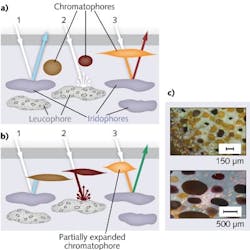ELECTRONIC PAPER DISPLAYS: Kindles and cuttlefish: Biomimetics informs e-paper displays
Both electronic paper (e-paper) and certain biological organisms share the need for adaptive, reflective surfaces to communicate information. The goal of each is to use numerous colors, textures, polarization, and contrast variations without optical losses in order to maximize and control (in an energy-efficient way) the desired physical appearance. Recognizing these display commonalities, researchers at the University of Cincinnati (Cincinnati, OH), the USA Marine Biological Laboratory (Woods Hole, MA), the Air Force Research Laboratory at Wright Patterson Air Force Base (Dayton, OH), and the Army Research Laboratory (Adelphi, MD) are attempting to merge the knowledge base of biomimetics used for biological adaptive coloration and appearance (with a focus on cephalopods such as squid, cuttlefish, and octopus) and synthetic reflective e-paper displays (such as Amazon’s Kindle and the Sony Reader) using a series of scientific metrics.1
Adaptive reflectance metrics
Especially in color generation, e-paper still lags behind the 100-million-year head start of biological systems; consequently, optoelectronic display engineers should be studying biomimetics in greater detail. While comparing a squid and an Amazon Kindle is not highly meaningful, the researchers say that important comparisons can be made between the function and performance of biological pigments and reflectors (chromatophores, iridophores, and leucophores) and similarly functioning synthetic pixels and optoelectronic components (like e-ink).
In cephalopods, chromatophores provide color by compacting pigments inside a sac approximately 0.1 mm to 2.0 mm in diameter on time scales typically around 300 ms (see figure). The most closely related e-paper displays are electrokinetic and electrofluidic types, which spread or compact pigments using an electric field over hundreds of milliseconds, or use electromechanical force to stretch a bubble of pigment over tens of milliseconds, respectively.
Of the two approaches, cyan, magenta, and yellow electrokinetic films can create full-color images through subtractive color close to newsprint—currently the highest performance shown for synthetic adaptive color technology. Alternatively, electrofluidic methods switch on shorter time scales and are capable of producing full-color displays.
Unlike chromatophores that provide biological coloration, iridophores and leucophores function more as backreflectors. Iridophores are composed of periodic layers of cytoplasm, reflectin protein, or guanine crystals; are around 1 mm wide; and function as a multilayer reflector system to produce a 60% to 80% reflectance-peak shift in wavelength over roughly 100 nm, with subsets of iridophores in specialized bands from the ultraviolet (UV) to the infrared (IR) spectrum.
Operating on second-to-minute time scales (much slower than chromatophores), synthetic equivalents include optical microelectromechanical systems (MEMs) and photonic-crystal (PC) ink. MEMS can create on-and-off, black-and-white pixels by reflectance and can use side-by-side mixing for colors, but only over 33% of their area and with a narrow viewing angle and only 50% reflectivity. But PC inks span the UV through IR, with 60% to 70% reflectance and 100 ms switching speeds.
For leucophores, spherical granules (200–2000 nm diameter) inside the cell cause diffuse reflection like the 100-nm-sized granules of titanium dioxide (TiO2) in white paint. Here, numerous synthetic white reflectors beat biological capabilities, including 3M’s less-than-60-μm-thick films of multilayer birefringent polyethylene terephthalate or polyethylene naphthalate that reflect the entire visible spectrum with greater than 99% efficiency over nearly all angles and polarizations. In this case, synthetic technology surpasses biological organisms’ capabilities.
However, it is important to keep in mind that while humans are striving for the highest reflectance possible, biological organisms are trying to adapt to their environment and/or communicate with each other, so their requirements for reflectivity are less. Chameleons and lizards possess different chromatophore structures that could inform display engineers on synthetic alternatives not described here (or not yet developed).
Eric Kreit, a University of Cincinnati PhD graduate now working at Gamma Dynamics (Cincinnati, OH), says, “Our main goals in this work were threefold: to allow display engineers to learn from millions of years of natural selection and evolution; to help make biologists aware of the most advanced mechanisms and performance measurements used in synthetic reflective e-paper; and to give all scientists a clearer picture of the long-term prospects for capabilities such as signaling/communication and adaptive concealment.”
REFERENCE
1. E. Kreit et al., “Biological versus electronic adaptive coloration: how can one inform the other?” (Sept. 26, 2012); http://bit.ly/RVXqXc.
About the Author

Gail Overton
Senior Editor (2004-2020)
Gail has more than 30 years of engineering, marketing, product management, and editorial experience in the photonics and optical communications industry. Before joining the staff at Laser Focus World in 2004, she held many product management and product marketing roles in the fiber-optics industry, most notably at Hughes (El Segundo, CA), GTE Labs (Waltham, MA), Corning (Corning, NY), Photon Kinetics (Beaverton, OR), and Newport Corporation (Irvine, CA). During her marketing career, Gail published articles in WDM Solutions and Sensors magazine and traveled internationally to conduct product and sales training. Gail received her BS degree in physics, with an emphasis in optics, from San Diego State University in San Diego, CA in May 1986.
